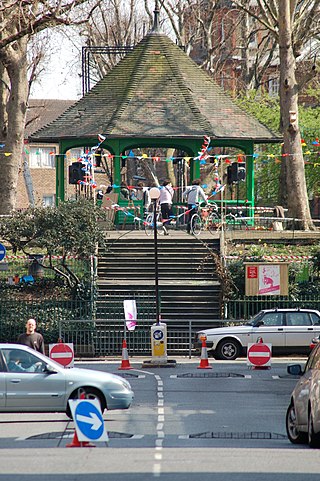
Bethnal Green is an area in London, England and is located in the London Borough of Tower Hamlets. It is in East London and part of the East End. The area emerged from the small settlement which developed around the Green, much of which survives today as Bethnal Green Gardens, beside Cambridge Heath Road. By the 16th century the term applied to a wider rural area, the Hamlet of Bethnal Green, which subsequently became a Parish, then a Metropolitan Borough before merging with neighbouring areas to become the north-western part of the new Tower Hamlets.

Stepney is an area in London, England and is located in the London Borough of Tower Hamlets. It is in East London and part of the East End. Stepney is no longer officially defined, and is usually used to refer to a relatively small area. However, for much of its history the place name applied to a much larger manor and parish. Stepney Green is a remnant of a larger area of Common Land formerly known as Mile End Green.

Whitechapel is an area in London, England and is located in the London Borough of Tower Hamlets. It is in East London and part of the East End. It is the location of Tower Hamlets Town Hall and therefore the borough town centre. Whitechapel is located 3.4 miles (5.5 km) east of Charing Cross.

Aldgate was a gate in the former defensive wall around the City of London.

Bethnal Green was a civil parish and a metropolitan borough of the County of London between 1899 and 1965, when it was merged with the Metropolitan Borough of Stepney and the Metropolitan Borough of Poplar to form the London Borough of Tower Hamlets.

Brick Lane is a famous street in the East End of London, in the borough of Tower Hamlets. It runs from Swanfield Street in Bethnal Green in the north, crosses the Bethnal Green Road before reaching the busiest, most commercially active part which runs through Spitalfields, or along its eastern edge. Brick Lane's southern end is connected to Whitechapel High Street by a short extension called Osborn Street.

Mile End is an area in London, England and is located in the London Borough of Tower Hamlets. It is in East London and part of the East End. It is 4.2 miles (6.8 km) east of Charing Cross. Situated on the part of the London-to-Colchester road called Mile End Road, it was one of the earliest suburbs of London.

Bow is an area of east London, England, within the London Borough of Tower Hamlets, 4.6 miles (7.4 km) east of Charing Cross.

The Blind Beggar is a pub in Whitechapel Road in the East End of London, England, at the junction with Cambridge Heath Road.

Old Ford is an area in the London Borough of Tower Hamlets that is named after the natural ford which provided a crossing of the River Lea.

The Boundary Estate is a housing development in the London Borough of Tower Hamlets, in the East End of London.

Oxford House in Bethnal Green, East London, was established in September 1884 as one of the first "settlements" by Oxford University as a High-Anglican Church of England counterpart to Toynbee Hall, established around the same time at Whitechapel.

The East End of London, often referred to within the London area simply as the East End, is the historic core of wider East London, east of the Roman and medieval walls of the City of London and north of the River Thames. It does not have universally accepted boundaries to the north and east, though the River Lea is sometimes seen as the eastern boundary. Parts of it may be regarded as lying within Central London. The term "East of Aldgate Pump" is sometimes used as a synonym for the area.

Columbia Road Flower Market is a street market in Bethnal Green in London, England. Columbia Road is a road of Victorian shops situated off Hackney Road in the London Borough of Tower Hamlets. The market is open on Sundays only.

St George in the East, historically known as Wapping-Stepney, was an ancient parish, in the London Borough of Tower Hamlets, England. The place name is no longer widely used.
Model dwellings companies (MDCs) were a group of private companies in Victorian Britain that sought to improve the housing conditions of the working classes by building new homes for them, at the same time receiving a competitive rate of return on any investment. The principle of philanthropic intention with capitalist return was given the label "five per cent philanthropy".
Katharine Buildings were model dwellings in Cartwright Street, Aldgate, London, the first project of the philanthropically-motivated East End Dwellings Company. The block was built during 1884, and opened in 1885 as model apartments for the working class. There were 628 single rooms with shared cooking and sanitary facilities, plus a top floor for the very poorest families. The buildings were named after the philanthropist Catherine Courtney.

Catherine Courtney, Baroness Courtney of Penwith, known as Kate Courtney, was a British social worker and internationalist. Active in charitable organisations in her early life, she later campaigned with her husband Leonard Courtney to end the Second Boer War and the First World War. She sought to bring attention to the plight of citizens of the enemy nations and was denounced as being overly sympathetic to the enemy during both wars.
Joseph Merceron (1764–1839) was a British businessman, property developer, parochial politician and magistrate notorious for his corrupt practices.
















